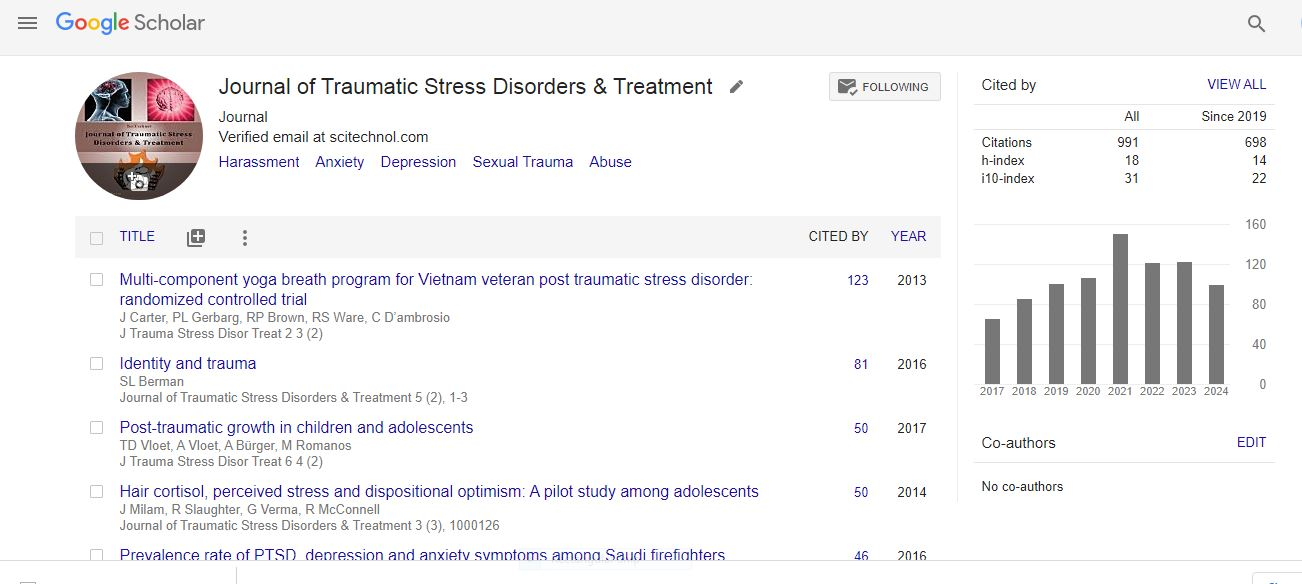Commentary, J Trauma Stress Disor Treat Vol: 10 Issue: 6
Abused Women and PostTraumatic Stress Disorder
Vladeta Ajdacic
Department of Psychiatry, Psychotherapy and Psychosomatics, Psychiatric Hospital, University of Zurich, Switzerland
Corresponding author: Vladeta Ajdacic *, Department of Psychiatry, Psychotherapy and Psychosomatics, Psychiatric Hospital, University of Zurich, Switzerland, Email: vladetacic@uzh.ch Citation: Ajdacic V (2021 Abused Women and Post-Traumatic Stress Disorder 10:(6) 241
Received: June 03, 2021 Accepted: June 17, 2021 Published: June 24, 2021
Keywords: Battered women; Depression; PTSD
Introduction
C-PTSD, a kind of PTSD that entails continuing trauma, can be caused by emotional abuse. Many of the symptoms of C-PTSD are similar to those of PTSD, albeit the symptoms and causes can differ. Treatment should be tailored to the scenario in order to treat the person's ongoing trauma from emotional abuse. Physical, psychological, and sexual abuse; terrorism and war; domestic violence; witnessing violence against others; and accidents and natural disasters are all examples of traumatic occurrences. They can cause severe anxiety and have negative implications for survivors and their families. In their lives, over half of all people (50 percent) will be exposed to at least one traumatic experience. Although the majority of people will be able to recover from their trauma over time, many survivors will have long-term issues. Posttraumatic stress disorder affects around 8% of survivors (PTSD). Many PTSD sufferers are currently dealing with symptoms that are both persistent and severe. Nightmares, sleeplessness, somatic disturbances, problems with interpersonal relationships, fear, anxiety, rage, embarrassment, aggression, suicidal behaviour, loss of trust, and isolation are only few of the symptoms. Depression, anxiety, and alcohol/substance abuse issues are some of the psychological disorders that can arise in conjunction with PTSD.
Keywords
Battered women; Depression; PTSD
Women at Risk
According to studies, women are twice as likely as males to acquire PTSD, have longer posttraumatic symptoms, and are more sensitive to cues that remind them of the trauma. Despite the fact that women are more likely than males to suffer negative repercussions as a result of traumatic situations, many women are hesitant to seek mental health therapy [1]. Survivors may have to wait years for aid, while others never receive treatment to all. Untreated posttraumatic symptoms not only have serious mental health consequences, but they can also have negative physical consequences.
Physical symptoms that female survivors may experience include headaches, gastro-intestinal issues, and sexual dysfunction. Despite the fact that the mental and physical symptoms of PTSD stress can be extremely severe, health providers frequently fail to diagnose trauma owing to a lack of expertise, time, and resources. Women who have experienced traumatic situations can benefit from a range of treatment options, including cognitive-behavioral therapy, group therapy, medication, and psychodynamic therapies.
Abuse-Related Variables
A self-developed question was used to assess the sort of abuse suffered before to entering the shelter: “What form of violence did you experience by [NAME ABUSER]?” One or more of the following alternatives were available to women: “Beatings, kicks, and things thrown at you” are examples of physical violence [2]. Sexual violence (“intimacy you didn't want or like, or rape, for example when he arrived home drunk”), and psychological violence (“threats, or he had no respect for your feelings, said hurtful things, or wouldn't let you go outside”).
Mental Health
The Dutch version of the Center for Epidemiological Studies Depression Scale was used to assess depressive symptoms. The CES-D is a 20-item self-report questionnaire about depression symptoms experienced in the previous week. The following is an example of one of the items: “I had a hard time focusing on what I was doing [3]. Item scores are graded on a four-point scale ranging from 0 (rarely or never) to 3 (often or never) (always or almost always). Total scores range from 0 to 60 and are divided into categories based on the following criteria: Scores 0-15.5 indicate no depression, 16-20.5 indicate mild depression, 21-30.5 indicate moderate depression, while 31 and higher indicate severe depression.
 Spanish
Spanish  Chinese
Chinese  Russian
Russian  German
German  French
French  Japanese
Japanese  Portuguese
Portuguese  Hindi
Hindi 
